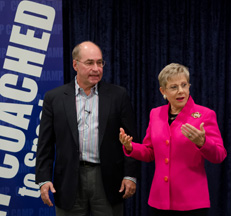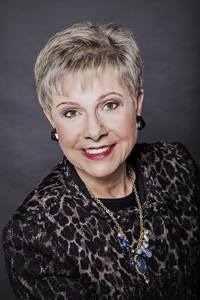
If you follow my blog you probably have heard me mention before that I have spoken at the Ragan Speechwriters Conference in past years. Ragan Communications publications are a wonderful source of information on communication – both in writing and speaking. The first time I spoke at their conference the opening speakers were Bill Clinton’s speechwriters. As you can imagine, these people write for history! The opening video introducing them featured Bill Clinton saying, “I have these three guys who write my speeches. I told them, ‘When I was Governor of Arkansas I gave four speeches a day and wrote them all myself. Why do I need you?’ They tell me now that I am the President if I say the wrong thing I can start a war.” Here is some advice from White House speechwriters reminding us that – a speech should focus on ONE topic!
Former White House Speechwriter: Focus on Just One Thing
Clinton speechwriter Jeff Shesol tells how to focus your speech, become educator-in-chief, and write like Hemingway, not like Faulkner.
by Russell Working
Former White House adviser Rahm Emanuel, now mayor of Chicago, was a demanding message cop for President Bill Clinton’s speechwriters.
When writers gathered to discuss all the points that had to be included in a speech, Emmanuel would sit jiggling his knees impatiently, says Jeff Shesol, former deputy chief speechwriter for Clinton.
Eventually, Emanuel would explode “like clockwork,” slam his fist on the table, and say, “Look, this speech is about one thing! One thing!”
Shesol adds: “And then he would tell us what it was. And then he would leave.”
Focus on one key idea
Like Emanuel, become a message cop.
“What is the one point?” he says. “What is the one takeaway? And whether the speech is 20 minutes or whether it’s an op-ed of 800 words, you’ve got to be just disciplined, and everything that’s not relevant to that needs to fall away.”
Seize the role of educator-in-chief
Sometimes the purpose of a speech is to nudge the public conversation along, not win wholesale conversions. Shesol cites Franklin Roosevelt’s “Arsenal of Democracy” speech in December 1940—a time when the U.S. was largely isolationist.
“He was preparing the public for a war they were strongly opposed to, fighting a war that was almost sure to come,” Shesol says.
In the speech, FDR insisted that there can be no appeasing of the Nazis. “No man can tame a tiger into a kitten by stroking it,” he said.
The speech helped prepare the public for the war that would come a year later.
Trust your intuition
Everything’s about measurement these days, but sometimes a speech can make a difference in ways that can’t be summed up in numbers.
Think of Abraham Lincoln at Gettysburg, or Woodrow Wilson on the eve of World War I, defining America as a beacon of freedom, Shesol says. If a sound bite gets picked up and repeated, you’ve done a good job, even if it’s impossible to apply metrics to prove your success.
Write Hemingway, not Faulkner
President Clinton was famed for his mastery of policy and his extended digressions from his text. His delivery was more like the prose of William Faulkner, famous for his evocative but tangled sentences, than that of Ernest Hemingway.
As a colleague of Shesol’s used to say, “We give him Hemingway, and he delivers Faulkner.”
But speechwriters need to strive for clarity and simplicity, even when their leader is as loquacious as Faulkner.
If the structure of the speech was clear, it was easy for Clinton to veer off, then return to the text.
Plan ahead
If you are launching a campaign of speeches, consider the trajectory of your messaging. The Clinton White House would develop a message of the week and even map out “where we want to be six months from now.”
When Clinton wanted to normalize trade relations with China, he gave a framing speech and then took his campaign on the road to the high-tech industry and to a Harley-Davidson factory, Shesol says.
“We kept the drumbeat going,” he says.
But a series of speeches should be varied in tone. He cites FDR, who said you can’t always be hitting the high notes on the scale or you’ll sound like a stuck whistle.
Take the argument to your critics
The role of a corporate leader has become much more like that of a U.S. president in recent years, Shesol says. It’s no longer enough just to address the board, shareholders, and the Chamber of Commerce.
This makes CEOs nervous, Shesol acknowledges. Most don’t want to get in a running public argument, and they would rather give a positive speech.
“But when they are running into this [criticism],” Shesol says, “the only way to deal with it is to squarely take on some of the arguments.”

Thank you Russell! Russell Working is a reporter for Ragan Communications. Follow Russell Working on Twitter: @byworking Thank you Ragan for great articles that inspire us to be more focused in our presentations!
![]() If you want to become a great speaker easily, conveniently, and quickly, Fripp Virtual Training can help. Enjoy three free chapters on Stories, Openings, and Sales: http://frippvt.com
If you want to become a great speaker easily, conveniently, and quickly, Fripp Virtual Training can help. Enjoy three free chapters on Stories, Openings, and Sales: http://frippvt.com
“I wanted a super bowl-quality coach, and I was lucky to be introduced to Patricia Fripp. Her help in coaching and scripting was world class. With Patricia Fripp on your team, you can go places.”
– Don Yaeger, Long-Time Associate Editor for Sports Illustrated magazine, Award-Winning Keynote Speaker, New York Times Best-Selling Author
Enjoy a free trial of FrippVT!
Executive Speech Coach and Hall of Fame Keynote Speaker Patricia Fripp works with those who realize that powerful, persuasive presentation skills give them a competitive edge.
